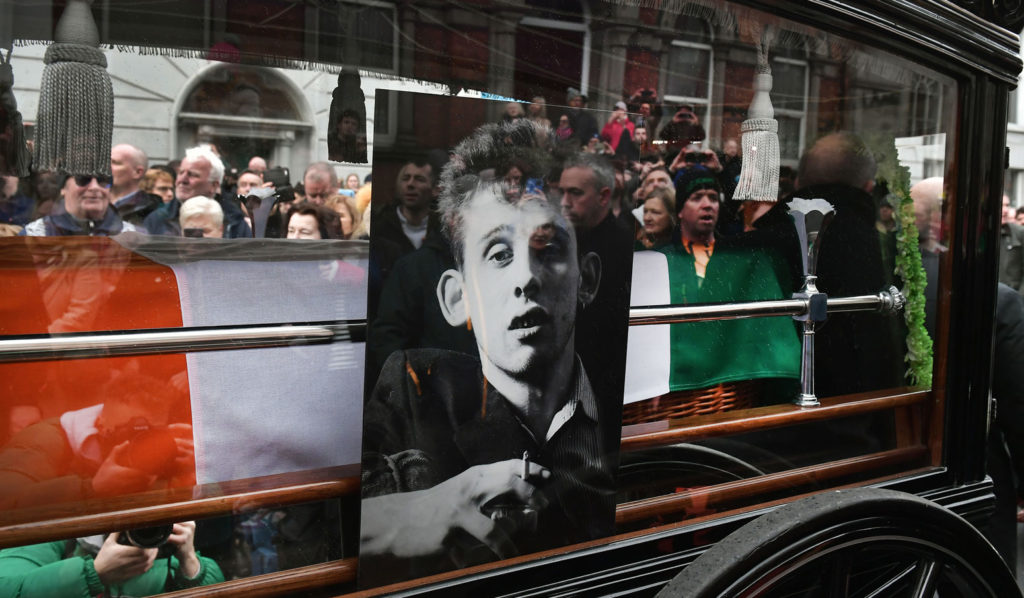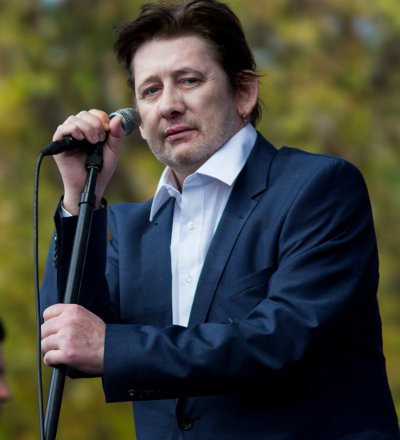THE death of Shane MacGowan brought down the curtain on a life which had given a voice to generations of Irish immigrants across the globe.
Despite his English accent and a private school education, McGowan was universally accepted as one of the Emerald Isle’s own.
Fittingly, he was laid to rest in Tipperary, even if there was a time this young punk roamed the streets of London in Union Jack colours.
In many ways, MacGowan’s journey from outsider to Irish cult hero mirrored that of Irish soccer team.
Fairytale of New York was released in 1987, just prior to Ray Houghton, a Scot, sticking the ball in the English net at the 1988 Euros.
Jack’s Heroes, by MacGowan and co, chronicled the relationship between the team and the diaspora ahead of the Italia ‘90 World Cup.
‘They’ll come from Dublin, and from Cork, from dear old Donegal, from London, Boston and New York, from anywhere at all.’
Jack Charlton’s squad was littered with players who, like MacGowan, weren’t born on the old sod.
Some 16 of the 22-man squad that travelled to Italy were foreign-born, yet they united a nation when positivity was thin on the ground.
There isn’t an Irish person alive who can’t tell you where they were when ‘the nation held its breath’ as David O’Leary dropped to his knees in sheer ecstasy following his penalty winner against Romania in Genoa, as Ireland nabbed a quarter final spot against hosts Italy.
The celebrations and Streams of Whiskey that followed for Irish soccer fans throughout the world are heights we can only dream of today.
For manager Charlton, player recruitment under the granny rule was key.
Kevin Sheedy (Wales), Ray Houghton (Scotland), Andy Townsend, Tony Cascarino (England) and the match winner O’Leary (Dublin via Stoke Newington) were penalty takers on that famous day.
Despite their various accents they all have places in Irish sporting history.
See back then, playing for Ireland wasn’t a hard sell. Today tells a different story.
Charlton was relentless in his recruitment of second and third generation Irish players.
He knew that without children of the diaspora on board, Ireland couldn’t compete against the world’s best.
Today, the senior men’s national team’s inability to recruit and retain the sons of Eire mirrors the changing nature and expectations of the Irish community in Britain.
 Crowds of people lined the streets of Dublin for the funeral procession of Shane MacGowan earlier this month (Image: Charles McQuillan/Getty Images)
Crowds of people lined the streets of Dublin for the funeral procession of Shane MacGowan earlier this month (Image: Charles McQuillan/Getty Images)There are no MacGowans any more.
The pubs and clubs our man frequented in Camden, Archway, County Kilburn and Cricklewood aren’t packed to the rafters with Irish immigrants.
Some of them no longer exist.
The Facebook group ‘Memories of Irish contractors and Subbies in the UK’ is full of songs and stories about days when men would line up for work; about the brutal and the brilliant from building sites; about the nights of drinking and craic.
People crave this brand of nostalgia because those days aren’t coming back.
The 2022 census showed that the Irish population in Britain is withering.
From 407,357 a decade ago, it now stands at some 324,670, a fall of 80,000 or 20%.
Once the biggest group of UK migrants, the Irish now sit in fifth behind Indians, Poles, Pakistanis and Romanians.
London, in particular, no longer has an area which can be defined as Irish.
People are scattered all over the city and further afield to Essex, Hertfordshire and Bedfordshire.
Very few youngsters with an Irish parent or grandparent spend their once-obligatory six weeks summer holidaying in the old country.
Today’s kids aren’t saturated in all things Irish like the second generation were in the 70s, 80s and 90s.
Seeing MacGowan and the Pogues at the Brixton Academy or Kentish Town Fourm wasn’t, of late, some big, fabled homecoming.
Yes, the Irish centres in Camden and Hammersmith remain, but few teens go there to engage with their ancestry.
The love affair with the magical land of green fields, music and craic isn’t what it once was.
Part of this is that we’ve given Ireland to the world and haven’t been immune to corporatising the magic that once made trips there almost spiritual.
If there’s a bigger rip off in Europe than Temple Bar then I definitely don’t want to go there.
For many Irish families there just aren’t enough relatives now left back home to justify regular trips across the water.
That the social situation has improved greatly for prior generations of Irish is almost miraculous.
From initial hostility and very limited access to lodgings or jobs, sons and daughters of Ireland became socially mobile enough to buy homes, start businesses and raise families.
Some older Irish are so much part of British life that they vocally championed Brexit. Something about too many immigrants in Britain.
The smaller numbers of Irish that have moved here since the 1990s are generally well-educated professionals working in media, finance, education and business.
They were raised on British culture through music, television and sport.
For them, life in the UK is no shock.
What’s more, they can fly home for cheap, and have no need at all to base their social lives in community centres or big Irish dance halls.
Ask the older generation if they’d like to move home and there’d be little-to-no interest.
A holiday home is as close as some want to get.
Many Irish moved to Britain thinking they would return home within a few years but wound up building good lives for themselves as Britain offered opportunities Ireland didn’t.
They continue to see their children prosper and enjoy the anonymity big cities like London and Manchester provide.
Often, those who never left Ireland resent the ones who did.
With ties to Ireland loose and shaky versus days gone by, is it any wonder that the Irish soccer team can’t get the second generation stars on board anymore?
Manchester City’s Jack Grealish and Arsenal’s Declan Rice are the most high profile players to switch international allegiance from Ireland to England in recent years.
 The likes of Shane MacGowan may never be seen again
The likes of Shane MacGowan may never be seen againLike MacGowan, Grealish is no stranger to a good night out.
He attended a catholic school and played Gaelic football for John Mitchells, scoring a point for Warwickshire at Croke Park.
His background reads as tailor-made for a star in a green jersey that’d dominate advertising space from Cork to Kildare.
Yet it was almost a given he’d switch to England when the time was right and these days he’s a poster boy for all things Birmingham and England.
Rice grew up supporting Chelsea and idolising John Terry, for some reason.
Despite his Up the IRA tweet and grandparents from Douglas in county Cork, it’s once again no shock that Rice gladly belts out God Save the King like he never stepped foot on Irish soil.
Ireland was merely a fallback until England came a-calling.
Rice and Grealish didn’t spend huge amounts of time in Ireland.
Their parents were not born in Ireland. They felt at home in England.
That wasn’t the deal for Shane MacGowan’s parents, nor many others of that time.
Maurice and Therese MacGowan never fully settled in England hence young Shane stayed with his grandparents in Tipperary until school age.
The reality is that Ireland today only gets those players England don't want - céad míle fáilte Callum Robinson and Josh Cullen.
The English FA are relentless in their recruitment of dual nationality players and Gareth Southgate’s squad has more than a hint of green to it.
There’s Rice and Grealish, sure, but there’s also Harry Kane, Jude Bellingham, James Maddison, Kalvin Phillips, Harry Maguire and Conor Gallagher.
All qualify for Ireland under the granny rule.
Under Charlton, the joke was that FAI stood for Find Any Irishman.
If anything, that’s an English motto now.
England have an entire department dedicated to recruitment and retention of dual national players.
Any hint of an Irish link and the English FA will endeavour to get to the player and their family first.
The English have their house in order, yet the FAI are stuck on the Streets of Sorrow.
We’re still reeling from financial mismanagement under John Delaney, who bowed out in 2019 leaving €55million of debt.
Stephen Kenny’s disastrous tenure has only just come to an end.
Our men’s national team desperately need a boost. A main sponsor would be a start. As would qualifying for something.
Maybe we’ve too long relied on telling tales of good old Ireland when trying to engage new young players.
That just won’t cut it anymore. Lions or Shamrocks, kids want to be part of success stories and Ireland needs a new yarn; the kind MacGowan spun beautifully.
The bookies put former internationals Lee Carsley and Chris Hughton as the favourites to replace Kenny in the Ireland hot seat.
Both men hold far stronger cards than Kenny if the game is convincing a youngster to play for Ireland. But even then, it’s a hell of an ask.
Because maybe MacGowan’s Ireland no longer exists.
Perhaps in giving Ireland to the world (and the world to the Irish) the mystique that fuelled our country’s magnetism evaporated in proportion to the opportunities of the new.
What, today, is our compelling case as we ask young talent to tog out and stick with Ireland?
It’s not nostalgia, it’s not success, it’s not family loyalty.
Maybe those concepts are gone and we need to rewire our game entirely.
Maybe success is the next generation of immigrants, the Albaninans, the Nigerians and the Poles, being prepared to do for Ireland what the diaspora no longer will.
And maybe that should be the measure of our dreams.

